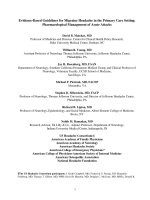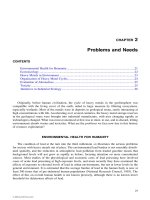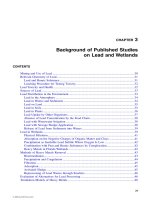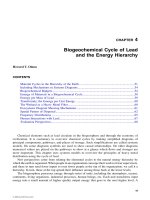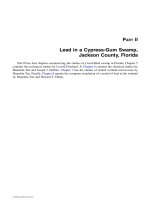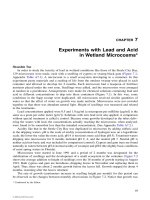Heavy Metals in the Environment: Using Wetlands for Their Removal - Chapter 6 doc
Bạn đang xem bản rút gọn của tài liệu. Xem và tải ngay bản đầy đủ của tài liệu tại đây (301.08 KB, 5 trang )
81
CHAPTER
6
Lead Distribution in Steele City Swamps*
Shanshin Ton and Joseph J. Delfino
CONTENTS
Lead in Surface Waters 82
Lead in Sediments 82
Lead in Vegetation 84
Chemical Properties of Lead in Sediments 84
Binding of Lead to Humic Substances 84
In 1970, Sapp Battery Service, Inc. initiated its operations to process lead recovery from used
automobile batteries. The company gradually expanded its operation to process approximately 50,000
used batteries per week in 1978. Wastes from operations were dumped outside the plant and allowed
to run through adjacent wetlands, finally being discharged to Steele City Bay (Figure 6.1).
After 7 years of operation, in 1977, the first complaint about damage to cypress trees in adjoining
wetlands was reported to the Florida Department of Environmental Regulation (FDER). FDER
closed the site in January 1980.
After the site was abandoned, EPA undertook emergency cleanup actions under provisions of
the Clean Water Act, Section 311. The Sapp Battery site was included on the final National Priorities
List in August 1982.
After that date, EPA cooperated with FDER to conduct the Remedial Investigation/Feasi-
bility Study (RI/FS). In this study, the on-site soils, groundwater, surface water, and sediments
were examined.
In 1985, Ecology & Environment, Inc. (E&E) became involved in field investigations to further
delineate the extent of the contamination. Another draft feasibility study was finished by E&E in
January 1987. See Appendix Table A6
B
.2.
The analyses of lead were made from April 1989 to September 1992. Samples first collected at
stations A through G (Figure 6.1) later extended further downstream in a series of sites: A, B, C, F,
OF1, G, and OF2 (Figure 1.3). Descriptions of the sampling sites are given by Ton (1993). The
chemical methods used are given in Appendix A6
A
, and Appendix A6
B
has a tabular listing of data
on lead in waters, sediments, vegetations, and related limnological data for April 1989 to May 1992.
* Condensed by the Editor.
L1401-frame-C6 Page 81 Monday, April 10, 2000 4:34 PM
© 2000 by CRC Press LLC
82 HEAVY METALS IN THE ENVIRONMENT: USING WETLANDS FOR THEIR REMOVAL
LEAD IN SURFACE WATERS
Lead concentrations in surface waters decreased downstream (Figure 6.2). Concentrations
in most samples were less than those reported in earlier years (Appendix Tables A6
B
.2 and
A6
B
.3), and most concentrations were less than the 0.03 mg/l regarded as safe for recreation,
fish, and wildlife.
LEAD IN SEDIMENTS
Concentrations of lead in sediments also decreased downstream (Figure 6.3). For the most part,
lead concentrations were highest in the surface sediments with lower concentrations 15 to 45 cm
below (Figure 6.4). These results indicated that the distribution of lead in sediments corresponds
to the surface water drainage pattern. Relatively low lead concentrations outside the boundary of
the study area suggest that the wetland acts as a filter to retain lead (Appendix Table A6
B
.5).
Figure 6.1
Location of sampling sites, Jackson County, Florida (Ton, 1990).
Site
Location
Florida
Sapp
Battery
Site
West
Swamp
East Swamp
County Rd. 280
Steele
City Bay
N
U.S
Rd.
231
County
Rd. 276
Destruction of Cypress Community
meters
200
400 600
800
A
B
C
D
F
G
L1401-frame-C6 Page 82 Monday, April 10, 2000 4:34 PM
© 2000 by CRC Press LLC
LEAD DISTRIBUTION IN STEELE CITY SWAMPS 83
Figure 6.2
Concentration of lead in surface waters as a function of distance from original discharge (Station
A in Figure 6.1) (Ton, 1990).
Figure 6.3
Concentration of lead in upper sediments (0 to 15 cm) as a function of distance from original
discharge (Station A in Figure 6.1) (Ton, 1990).
Figure 6.4
Lead concentrations in sediment profiles at Stations A through G in Figure 6.1 (Ton, 1990).
n
n
n
n
n
n
Sampling sites
A
B
C
F
D
0.3
0.2
0.1
0.0
0
100
200 300
400
Distance, m
Lead concentration, mg/L
500
600
700
G
n
n
n
n
n
n
Sampling Sites
A
B
C
F
D
0
0 100
200 300
400
Distance, m
Lead Concentration, mg/g
500
600 700
G
500
400
300
200
100
0
500
400
300
200
100
600
Depth
0-15 cm
15-30 cm
30-45 cm
Sampling sites
A1
A2 B1
B2 C1
C2 D1
D2
F1
F2
G1
G2
Lead Concentration, ppm
L1401-frame-C6 Page 83 Monday, April 10, 2000 4:34 PM
© 2000 by CRC Press LLC
84 HEAVY METALS IN THE ENVIRONMENT: USING WETLANDS FOR THEIR REMOVAL
LEAD IN VEGETATION
Water lily (
Nymphaea odorata
) was the most popular species for the entire wetland, except site
A. Leaves, stems, and roots of water lilies were separated for lead analysis. Generally, concentrations
of lead in leaves and stems were slightly higher than those in roots. However, high concentrations
of lead accumulated in roots were found commonly in other species (Appendix Table A6
B
.8).
CHEMICAL PROPERTIES OF LEAD IN SEDIMENTS
Sequential chemical extraction (Appendix A6
A
, Table A6
A
.1) was used to separate six compo-
nents of lead in sediments, each followed by lead determinations. Exchangeable lead was extracted
with potassium nitrate solution; adsorbed lead was removed with potassium fluoride; organically
bound lead with sodium phosphate; inorganic precipitated lead with EDTA; sulfide lead with nitric
acid; and residual lead. Results are given in Appendix A6
B
, Table A6
B
.9 and Figure 6.5.
BINDING OF LEAD TO HUMIC SUBSTANCES
As already known from the literature and confirmed with the study of lead fractions (Figure
6.5), much of the lead combines with humic substances. To measure the binding to the humic
substances in the waters of the study area, 40 gal of surface water was collected from the control
pond near the Sapp swamp in June and July 1991. A dialysis apparatus was set up (Figure 6.6) so
that lead in solution on one side of a membrane could diffuse through the tiny pores, some becoming
Figure 6.5
Percentages of total sedimentary lead in each of six fractions at six stations in Figure 6.1 (Ton, 1990).
.
.
.
.
.
.
40
30
20
10
0
Organically
Bound
Carbonate
Sampling Site
Sulfide
Residual
A
B
C
D
F
G
Exchangeable
Adsorbed
Percent of Total Lead
Chemical State
50
L1401-frame-C6 Page 84 Monday, April 10, 2000 4:34 PM
© 2000 by CRC Press LLC
LEAD DISTRIBUTION IN STEELE CITY SWAMPS 85
bound by the humic substances in solution on the other side. One side of the membrane had lead
solution only, whereas the other side had lead solution plus that bound in the organic matter. After
suitable calculations were made using Scatchard graphs (Appendix Figure A6
A
.3), the ratio of lead
bound to humic matter was found to be about 1.5 g lead per kilogram organic matter, slightly more
at higher pH, and about half the binding by a sample of humic materials (Aldrich Chemical Co.,
purified and freeze dried by Davis [1993]).
A small amount (2.9 to 6.2%) of the organic humic molecules diffused in the other direction
across the membrane, as measured with an instrument measuring the absorption of ultraviolet light.
The lower the pH the more diffused, suggesting an effect of pH in making the molecules more
compact (already known from past publications). The humic substances from the bay diffused more
than the sample of standard humic substance (less than 1%). In other words, the humic molecules
from the control swamp were smaller than those in the standard humic material.
Figure 6.6
Dialysis apparatus used for measuring the binding of lead by humic substances.
Dialysis
Capsule
Lead
Solution
Stirring Bars
Pump
Stirrer
Sample of
Dissolved
Organics
Pump
Mf = Free Metals
Mt = Total Metals
Stirrer
L1401-frame-C6 Page 85 Monday, April 10, 2000 4:34 PM
© 2000 by CRC Press LLC

